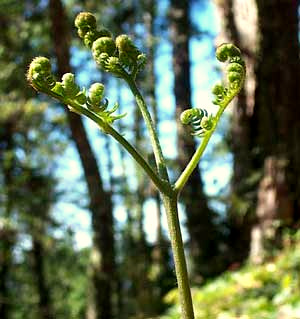Excerpts from Jim Conrad's
Naturalist Newsletter
from the October 29, 2007 Newsletter issued from Yerba Buena Clinic just outside Pueblo Nuevo Solistahuacan, Chiapas, MÉXICO
about 1740 meters in elevation, ± LAT. 17° 11' 27"N, LONG. -92° 53' 35"W
BRACKEN
Our most common fern here also should be familiar to North Americans, not because it's an eastern-forest relict but because it's surely the most common fern species in the world, found practically worldwide. It's Bracken, also known as Brake, PTERIDIUM AQUILINUM. You can see a typical Bracken frond near my dwelling below.

Note the frond's overall triangular shape and how it's divided into three large subdivisions, each of which are further divided into smaller sections, some of which in turn are themselves divided into small, distinct segments, or pinnules. Such thrice-divided fronds are said to be tripinnate. Bracken fronds can grow three feet high and higher. Despite the fern's coarse aspect, its fronds unfurl in the same delicate, rolling-out fashion of other fronds, seen below.

You may know how fern spores are often produced in distinctively shaped "sori," or "fruit dots," on a frond's undersurface, with the sori distributed in characteristic patterns. All this is explained on my fern page at www.backyardnature.net/ferns.htm.
Bracken uses a different system. Its spores arise from long, slender sori clustered inside the fronds' curled-under margins. If you have Bracken in your area, tear across a frond margin, look at it across the break, and you'll see it.